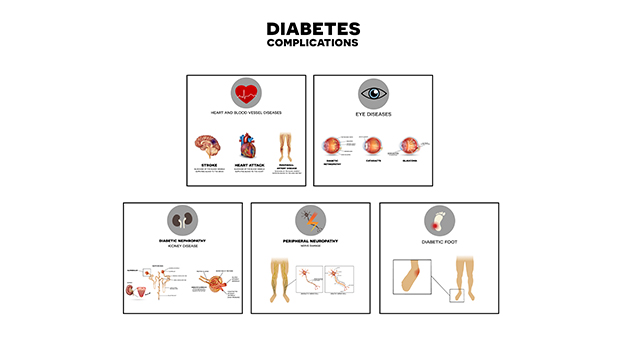Diabulimia: It’s Real and It’s Dangerous

Stephanie Savarence, a 31-year-old mom of two, says she discovered insulin’s weight loss potential by accident. As a busy new mom, Stephanie started forgetting some of her injections and noticed her baby weight dropping quickly. After the healthy birth of her second baby, Stephanie says she immediately went back to those old habits.
“I was the skinniest I had ever been in my adult life, and was constantly being told how great I looked,” she says. “I didn’t feel too many bad effects for a while. The thirst became normal routine for me. Eat what I want, how much I want, when I want, do nothing and lose weight.”
For some people with diabetes, manipulating insulin to achieve weight loss has turned into a dangerous phenomenon nicknamed “diabulimia.” Diabulimia is a portmanteau of diabetes and bulimia and is believed in some estimates to affect approximately 30% of women with Type 1 diabetes.
One of the hallmark behaviors is eliminating or drastically reducing insulin, which starves the body and requires it to use fat for energy. Because the body is spending an extended time at extremely high blood sugar levels, people with diabulimia often suffer complications, like gastroparesis, neuropathy, and retinopathy, at a much younger age.
Type 1 diabetes often leaves people heavily focused on food and preoccupied with their body, explains Dawn Taylor, a psychologist and therapist at Park Nicolett’s Melrose Clinic, an eating disorder recovery center in Minneapolis with a program for people with Type 1 diabetes. Others may develop the eating disorder because of the weight gain that happens once the body goes on insulin after a diagnosis and the body uses glucose, instead of fat, for energy.
Signs of diabulimia can include:
- rapid weight loss
- an elevated A1C
- several admissions of diabetic ketoacidosis (DKA) in a short period of time
- inconsistent blood sugar monitoring
- symptoms of high blood sugar, including frequent urination, excessive thirst, low energy, and irritability
- avoiding eating in front of others
- other signs of disordered eating like restricting food or overexercising.
Savarence suffered with diabulimia for eight years before she sought treatment for it, but by then many complications had already started.
“In the spring of 2013, I found out I was in the beginning stages of kidney failure,” she says. “My kids then were six and eight years old, and their mom was going to die.”
Even with the complications, Savarence struggled with her recovery. Many health care professionals are not educated about eating disorders and Type 1 diabetes and she had trouble finding resources. She had many false starts with her recovery and found herself sliding back into old habits.
“The only way to do it was to mentally prepare myself for the weight gain and embrace it,” she says.
Resources are few and far between for people with diabetes and eating disorders, but there are some eating disorder clinics, like the Melrose Center, that have embraced the need for specialized care. Other organizations, like We Are Diabetes and the Diabulimia Helpline, work to connect people who want to work with treatment centers and local therapists.
At the Melrose Center, staff are trained to understand the nuances of both Type 1 diabetes and eating disorders.
“The whole message that we give is, ‘What do you need to do to maintain a healthy lifestyle?’” says Marcia Meier, a nurse and a certified diabetes educator who works at the Melrose Clinic. “It’s helping someone discover what a healthy weight is for them. There’s a lot of work on meal plans and on diabetes care, because you can’t just assume someone knows what they’re doing just because they’ve had it for a long time.”
If you think your loved one may have an eating disorder, intervene as early as possible using a non-hostile, non-judgmental approach, she recommends. Meier suggests showing concern for your loved one’s health, rather than using scare tactics or accusations.
“I have never seen people be motivated by the chance of complications,” says Meier. “It can’t be something that might happen. It has to be about what will they gain from doing better care.”
Dawn Akers has firsthand experience as the loved one of someone with diabulimia. Her daughter, Erin, developed diabulimia as a teenager. She has now recovered enough to found Diabulimia Helpline, a 24/7 service for people with diabetes, their families and friends, and health care professionals with questions. As a parent, Akers encourages parents and loved ones to be understanding when it comes to communicating with someone with diabulimia.
“An eating disorder is a mental illness, not a choice,” says Akers.
She says that even providing a pamphlet about diabulimia can open dialogue and help the person with diabulimia realize they have a problem or that it can be treated. All of this takes a lot of time and persistence, but it can pay off. Now 24 years old, Erin is the founder of Diabulimia Helpline, a 24/7 service for people with diabetes, their families and friends, and health care professionals with questions.
Recovery is a very active process, and people want to avoid what is hard, Taylor says. Loving persistence is a necessity, she says. Savarence agrees, calling recovery the hardest task she ever undertook.
“It takes a strong woman to fight through that hell, and stick it out. But when you come out the other side, not only do you feel good because you are taking care of your diabetes, you know that you are mentally one of the strongest creatures God made,” Savarence says.
To reach the Diabulimia Helpline, call (425) 985 – 3635 or go to www.diabulimiahelpline.org. To learn more about We Are Diabetes, go to http://www.wearediabetes.org/.
Thanks for reading this Insulin Nation article. Want more Type 1 news? Subscribe here.
Have Type 2 diabetes or know someone who does? Try Type 2 Nation, our sister publication.







